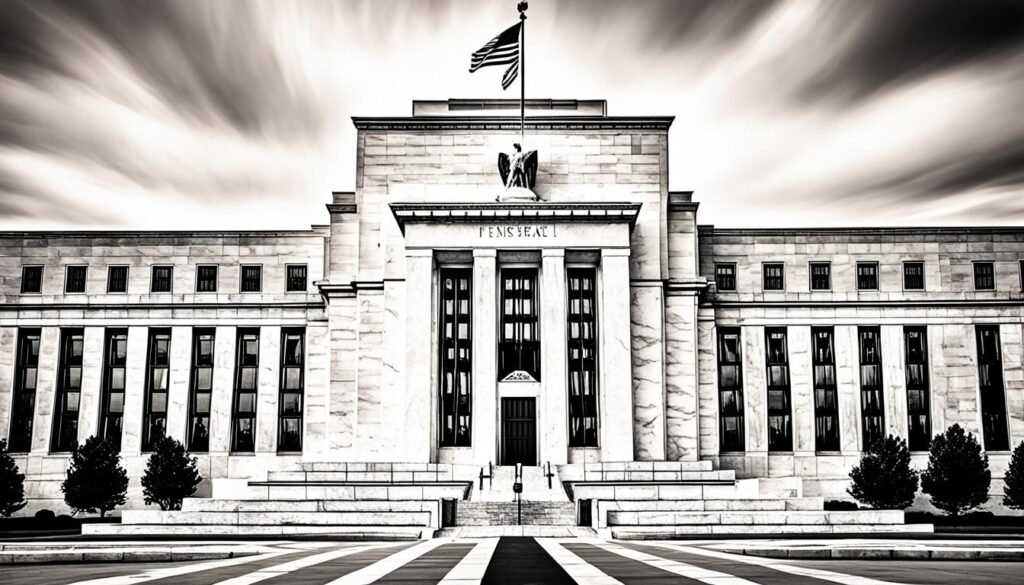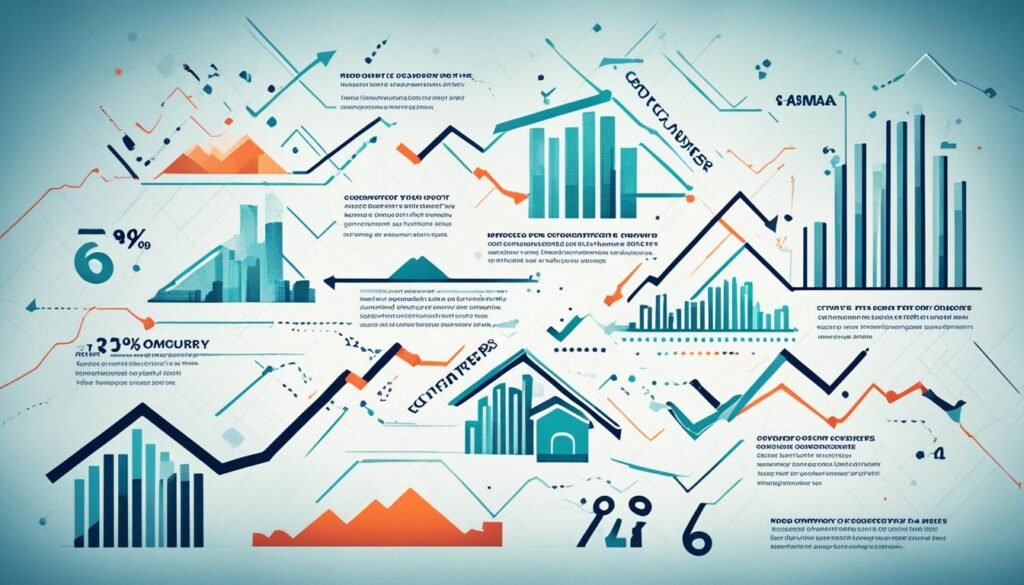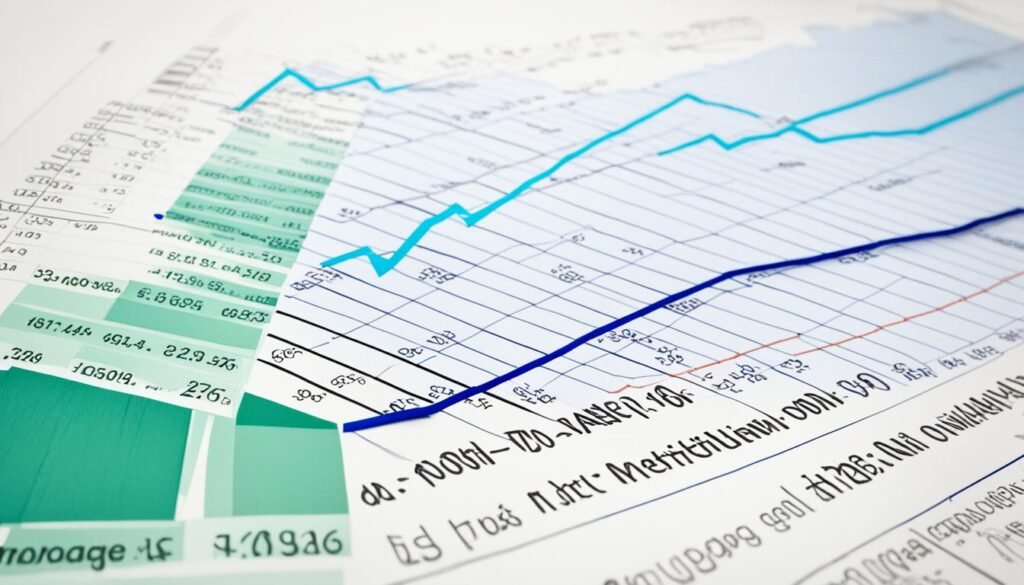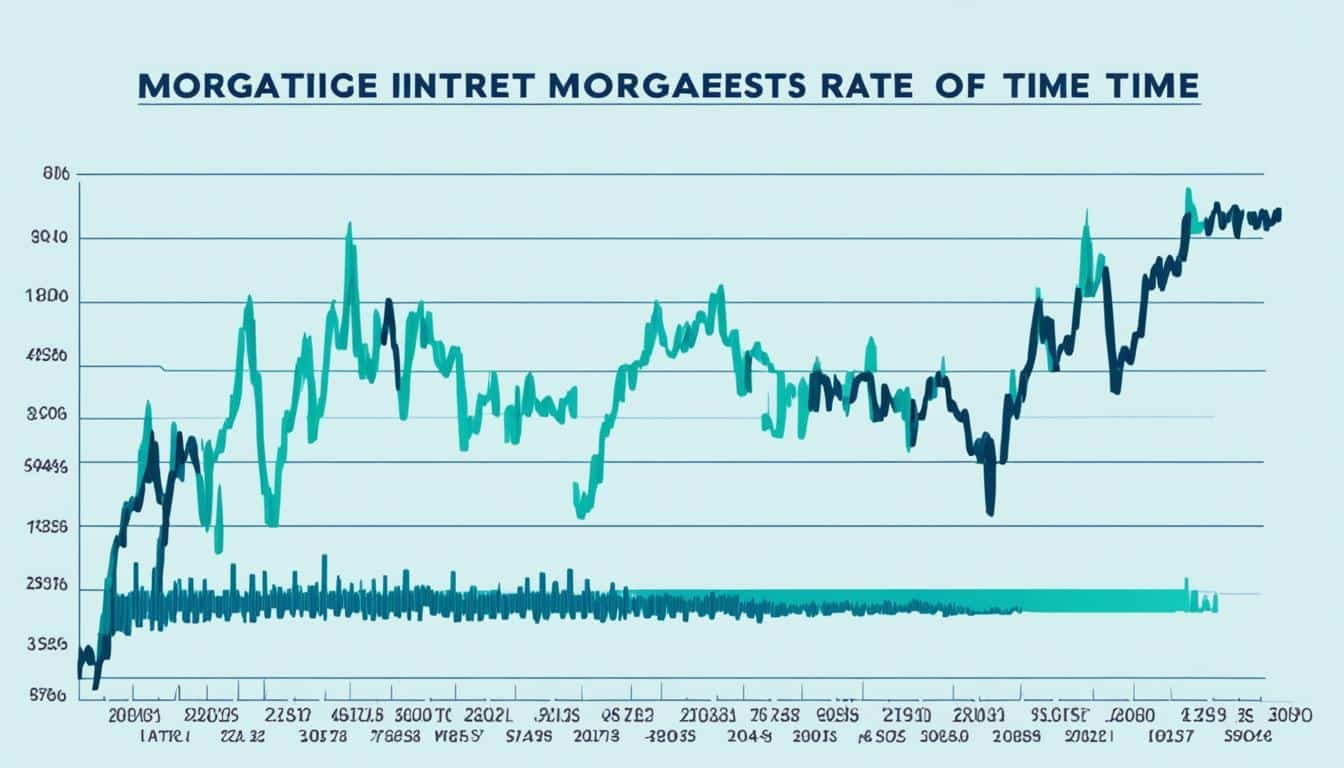Mortgage interest rates have a significant impact on the cost of financing a home. Borrowers seek the lowest possible mortgage rates, while lenders manage their risk through the interest rates they offer. The lowest rates are only available to borrowers with the most stellar credit scores. However, other factors affect the mortgage rate environment, reflecting the basic rules of supply and demand. These factors include inflation, economic growth, the Federal Reserve’s monetary policy, the bond market, and housing market conditions.
Key Takeaways
- Mortgage interest rates have a significant impact on the cost of financing a home.
- Borrowers seek the lowest possible mortgage rates, while lenders manage their risk through the interest rates they offer.
- The lowest rates are only available to borrowers with the most stellar credit histories.
- Other factors affecting mortgage rates include inflation, economic growth, Federal Reserve policy, the bond market, and housing market conditions.
- Understanding these factors is crucial for borrowers to secure the best possible mortgage rates.
Introduction
Mortgage interest rates play a crucial role in the cost of financing a home. On one hand, borrowers actively seek the lowest possible mortgage rates to minimize their monthly payments and the overall cost of their mortgage loan. On the other hand, mortgage lenders carefully manage their risk by adjusting the interest rates they offer to homebuyers. The most favorable mortgage interest rates are typically reserved for borrowers with the highest credit scores and strongest financial profiles.
Importance of Understanding Mortgage Interest Rates
Understanding the factors that influence mortgage interest rates is essential for homebuyers and homeowners alike. The interest rate on a mortgage can have a significant impact on the monthly payments and the overall cost of the loan over the life of the loan. Knowing how rates are determined can help borrowers make informed decisions and potentially secure a more favorable mortgage rate.
Overview of Factors Influencing Mortgage Rates
Mortgage interest rates are influenced by a complex interplay of economic factors, including inflation, economic growth, Federal Reserve monetary policy, the bond market, and conditions in the housing market. Additionally, mortgage lenders consider the creditworthiness and financial profile of individual borrowers when setting interest rates. Understanding these key factors can provide homebuyers with valuable insights to navigate the mortgage market more effectively.
Inflation and Its Impact

Inflation, the persistent rise in the prices of goods and services, can have a significant influence on mortgage lenders‘ rate-setting decisions. As inflation erodes the purchasing power of the dollar, it puts inflationary pressures on mortgage lenders, who must adjust their mortgage rates to maintain their real profits and protect their real net profit margins.
How Inflation Affects Lenders’ Rate-Setting
When inflation is high, lenders must factor in the erosion of their future returns due to the declining value of the dollar. To maintain their desired level of real profits, they will typically raise mortgage rates to offset the impact of inflationary pressures. This allows them to preserve their purchasing power and ensure their investment in mortgage loans remains profitable over the long term.
Maintaining Real Profits Amid Inflationary Pressures
As inflation rises, mortgage lenders must carefully balance their need to protect their real profits with the desire to offer competitive mortgage rates that remain affordable for borrowers. This delicate equilibrium is crucial for lenders to maintain a healthy and sustainable business model while navigating the challenges posed by inflationary pressures.
Economic Growth and Market Demand

Economic growth indicators, such as gross domestic product (GDP) and the employment rate, play a pivotal role in shaping mortgage rates. As the economic growth accelerates, the demand for mortgages tends to increase, leading mortgage lenders to adjust their offerings accordingly.
Relationship Between GDP and Mortgage Rates
When the GDP rises, it signals improved economic conditions and stronger consumer confidence. This, in turn, boosts the housing market and the demand for fixed-rate mortgages and adjustable-rate mortgages. As a result, mortgage lenders may respond by incrementally raising their mortgage rates to manage the increased demand and risk.
Impact of Employment and Consumer Spending
Similarly, a robust employment landscape and elevated consumer spending levels can exert upward pressure on mortgage rates. When more people are employed and consumers are actively spending, the housing market experiences heightened activity, leading to a surge in mortgage applications and an increased need for mortgage financing. This dynamic allows mortgage lenders to charge higher interest rates without significantly impacting the overall housing market demand.
Federal Reserve Monetary Policy

The Federal Reserve, commonly referred to as the Fed, plays a crucial role in shaping interest rates, including those that impact mortgage rates. As the central bank of the United States, the Fed is responsible for maintaining a stable financial system and promoting full employment and price stability.
Role of the Federal Reserve in Interest Rates
The Federal Reserve sets the Fed Funds rate, which is the interest rate at which banks lend to one another overnight. This benchmark rate directly influences other short-term interest rates, including those on adjustable-rate mortgages (ARMs). The Fed’s monetary policy decisions, such as raising or lowering the Fed Funds rate, can have a significant impact on the borrowing public, affecting their ability to access credit and the cost of that credit.
Effects of Fed Funds Rate and Money Supply
In addition to the Fed Funds rate, the Federal Reserve also has the ability to influence the overall money supply in the economy. By adjusting the money supply through various tools, such as open market operations, the Fed can indirectly affect long-term interest rates, including those on fixed-rate mortgages. These policy actions are aimed at achieving the Fed’s dual mandate of maximum employment and stable prices.
The Bond Market and Mortgage Rates

The bond market plays a crucial role in shaping mortgage interest rates. Banks and investment firms actively market mortgage-backed securities (MBSs) as investment products. These debt securities represent pools of mortgage loans, and the yields available from these MBSs must be sufficiently high to attract buyers in the bond market.
Mortgage-Backed Securities and Yields
Mortgage lenders often package individual mortgage loans into MBSs, which are then sold to investors in the bond market. The yields on these MBSs are closely tied to the prevailing yields on government bonds, particularly the 10-year Treasury bond yield. As the 10-year Treasury yield rises, the yields on MBSs must also increase to remain attractive to investors, leading to higher mortgage rates for borrowers.
Impact of Government and Corporate Bond Yields
The performance of the broader bond market, including government bonds and corporate bonds, also influences mortgage rates. When yields on government bonds and corporate debt securities rise, it puts upward pressure on the yields demanded by MBS investors, ultimately leading to higher mortgage rates for borrowers. Conversely, when bond yields decline, mortgage rates tend to follow suit, as the cost of funding mortgages becomes more favorable for lenders.
Mortgage Interest Rates

Mortgage interest rates are tied to the basic rules of supply and demand. Factors such as inflation, economic growth, the Federal Reserve’s monetary policy, and the state of the bond and housing markets all come into play when lenders set their mortgage interest rates. Of course, a borrower’s financial health will also affect the individual mortgage rates they receive, so it’s essential to maintain a strong credit score and overall financial health.
Factors Affecting Individual Mortgage Rates
Lenders carefully assess a borrower’s creditworthiness when determining the mortgage interest rates they will offer. Key factors include the borrower’s credit score, debt-to-income ratio, and loan-to-value (LTV) ratio. A higher credit score and lower LTV ratio (with a larger down payment) typically translate to lower mortgage interest rates, as the lender perceives the borrower as less risky.
Credit Score and Financial Health
A borrower’s credit score is one of the most important factors in determining their mortgage interest rates. Lenders view individuals with higher credit scores as less of a risk, and therefore offer them lower mortgage interest rates. Borrowers should focus on maintaining a strong financial health by monitoring their credit report, paying bills on time, and keeping credit card balances low.
Loan-to-Value (LTV) Ratio and Down Payment
The loan-to-value (LTV) ratio is the percentage of the home’s value that the borrower is financing with a mortgage. A lower LTV ratio, typically achieved with a larger down payment, signals to lenders that the borrower has more skin in the game and is less likely to default. This can result in lower mortgage interest rates and potentially lower mortgage insurance costs.
| Mortgage Type | Average Interest Rate |
|---|---|
| 30-Year Fixed | 6.75% |
| 15-Year Fixed | 6.25% |
| 5/1 Adjustable Rate | 5.50% |
Housing Market Conditions

The housing market conditions play a significant role in shaping mortgage rates. When the housing supply is limited and consumer demand for homes is high, it typically leads to an increase in mortgage rates. Conversely, when the housing supply is abundant, and home buying and renting activity slows, mortgage rates tend to decrease.
Supply and Demand in the Housing Market
Trends in housing supply and demand are closely tied to mortgage rate fluctuations. When fewer new homes are being built or existing homes are not being listed for sale, the decline in home purchasing leads to a decrease in the demand for mortgages. This, in turn, can push mortgage interest rates downward as lenders compete for a smaller pool of borrowers. Conversely, when housing supply is tight and consumer demand is high, lenders may raise mortgage rates to manage the increased risk.
Trends in Home Buying and Renting
Shifts in consumer preferences between home buying and renting can also impact mortgage rates. When more people are inclined to purchase homes, the demand for mortgages rises, potentially leading to higher interest rates. Conversely, if more consumers opt to rent rather than buy, the demand for mortgages may decline, putting downward pressure on mortgage rates.
Lender Variations and Rate Shopping

When it comes to securing a mortgage, borrowers often encounter variations in interest rates among different mortgage lenders. These differences can significantly impact the overall cost of a home loan, making it crucial for prospective homebuyers to engage in thorough rate shopping and rate comparisons.
Differences in Rates Among Lenders
The table below highlights average mortgage rates for first-time homebuyers for the 30-year fixed, 15-year fixed, and 7-year/6-month adjustable rate loan for some of the major banks as of Dec. 12, 2023. It’s important to note that mortgage rates can vary based on factors such as location and credit score.
| Lender | 30-Year Fixed | 15-Year Fixed | 7/6 Adjustable Rate |
|---|---|---|---|
| Bank of America | 6.75% | 6.25% | 6.50% |
| Chase | 6.80% | 6.30% | 6.55% |
| Wells Fargo | 6.85% | 6.35% | 6.60% |
| Citibank | 6.90% | 6.40% | 6.65% |
Importance of Comparing Offers
Given the variations in mortgage rates and mortgage offers among different lenders, it is crucial for borrowers to engage in thorough rate shopping and rate comparisons. By exploring multiple interest rate quotes and mortgage offers, borrowers can ensure they secure the most competitive mortgage rates for their unique financial situation and home purchasing needs.
Strategies for Securing Lower Rates

To secure the lowest possible mortgage rates, borrowers should focus on improving their credit score and overall financial profile. A higher credit score can earn you a lower interest rate on your mortgage loan, as lenders view you as less risky.
Improving Credit Score and Financial Profile
Review your credit report and address any errors or negative items that may be dragging down your credit score. Work on paying down debt and maintaining low credit card balances to demonstrate your financial responsibility. Additionally, consider increasing your down payment to reduce the loan-to-value (LTV) ratio, as this can also qualify you for lower rates.
Considering Points and Lender Credits
Evaluate the trade-off between mortgage points and lender credits when selecting your loan. Paying mortgage points upfront can lower your interest rate, but this may not be the best option if you don’t plan to stay in the home for an extended period. Alternatively, lender credits can help offset closing costs and upfront fees, potentially saving you money in the long run.
Understanding mortgage rates and how they impact your mortgage interest is crucial when working with a mortgage lender. Whether you’re considering a 30-year fixed-rate mortgage or comparing rates today for a 15-year fixed mortgage, finding the best mortgage rate can significantly affect your monthly mortgage payment and the total cost over the life of the loan. Utilizing a mortgage calculator can help you determine the principal and interest for different types of mortgages, whether it’s a fixed-rate mortgage or an adjustable-rate mortgage. Factors such as your credit score and mortgage points can influence your mortgage rate, with lower rates available for those with higher credit scores. Additionally, mortgage insurance may be required if you have a lower down payment, but you can explore options to lower your interest rate and potentially avoid mortgage insurance. By locking in the current rate and comparing mortgage rates for a jumbo mortgage or other types of loans, you can ensure you’re getting the best mortgage rate for your financial situation.
Mortgage landscape is dynamic, with mortgage rates subject to change and influenced by various factors. It’s essential to compare current mortgage rates from the best mortgage lenders to ensure you’re getting the most competitive rate for your 30-year mortgage or 15-year mortgage. Whether you’re looking to refinance your current mortgage or apply for a new one, staying informed about today’s mortgage interest rates is crucial. Rates can fluctuate based on market trends, and even a slight decrease in the interest rate by 0.25% can lower your mortgage payment significantly over time. Utilizing tools like a mortgage amortization calculator can help you understand the impact of different interest rates on your repayment plan. While some predict that mortgage rates will remain steady, others anticipate fluctuations, making it important to get preapproved for a mortgage and lock in a rate that works for you amidst potential changes in the market.
Also Read: How Global Economic Policies Influence Local Loan and Mortgage Rates
Conclusion
Mortgage interest rates are a complex and dynamic component of the housing market, influenced by a multitude of economic factors. These include inflation, economic growth, Federal Reserve policies, bond market conditions, and the state of the housing market itself. Lenders also consider borrowers’ individual financial profiles, such as credit scores, down payments, and debt-to-income ratios, when setting mortgage interest rates.
Understanding the factors that drive mortgage interest rate fluctuations is crucial for both borrowers and lenders. Borrowers can leverage this knowledge to secure the most favorable rates, while lenders can make informed decisions to manage their risk and maintain profitability. By staying informed about economic conditions and lender considerations, borrowers can develop effective strategies for obtaining the best possible mortgage rates, ultimately enhancing the affordability and accessibility of homeownership.
Ultimately, the mortgage interest rate landscape is a complex and ever-changing tapestry, woven together by a multitude of economic, financial, and market-driven forces. By staying informed and proactive, borrowers can navigate this landscape with confidence, making informed decisions that align with their long-term financial goals and the health of the housing market as a whole.
FAQs
Q: What factors determine mortgage interest rates?
A: Mortgage interest rates are influenced by factors such as the current state of the economy, inflation rates, the Federal Reserve’s monetary policy, the borrower’s credit score, loan amount, loan term, and type of mortgage.
Q: How do fixed-rate mortgages differ from adjustable-rate mortgages?
A: Fixed-rate mortgages have a consistent interest rate over the life of the loan, providing stability in monthly payments. In contrast, adjustable-rate mortgages have interest rates that can fluctuate depending on market conditions, potentially resulting in varying monthly payments.
Q: How can I get the best mortgage rate?
A: To secure the best mortgage rate, it is recommended to shop around and compare offers from different mortgage lenders, improve your credit score, make a higher down payment, and consider locking in the interest rate when rates are favorable.
Q: What is the national average interest rate for mortgages in 2024?
A: The national average interest rate for mortgages in 2024 can vary, but it is typically influenced by market conditions, economic factors, and the type of mortgage being offered.
Q: How do 30-year fixed-rate mortgages compare to 15-year fixed-rate mortgages?
A: 30-year fixed-rate mortgages have lower monthly payments but higher interest costs over the life of the loan compared to 15-year fixed-rate mortgages, which have higher monthly payments but lower total interest expenses.
Q: When should I consider refinancing my current mortgage?
A: Refinancing your current mortgage may be beneficial if current mortgage rates are lower than the rate on your existing loan, if you want to switch from an adjustable-rate to a fixed-rate mortgage, or if you aim to shorten the term of your loan.
Q: How do mortgage rate trends impact borrowers?
A: Mortgage rate trends can influence the affordability of loans for borrowers, affecting monthly payments, total interest costs, and the overall cost of homeownership. Staying informed about rate trends can help borrowers make informed decisions about when to apply for a mortgage.





